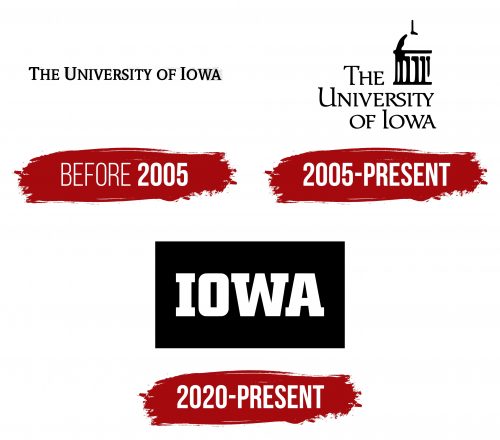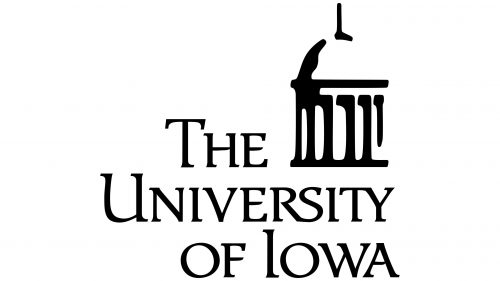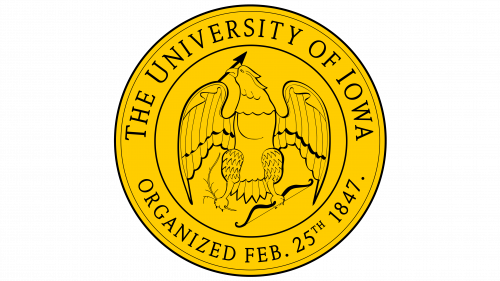The University of Iowa logo fully meets the criteria for recognition. It appears presentable, highlighting the high status of the educational institution. The logo is informative and visually appealing. The contrast of shades makes it easy to remember and recognize in any context.
Clear graphics and detailed lines characterize the university’s identity. The logo effectively conveys an impression of the university, whose operations encompass 12 state colleges.
University of Iowa: Brand overview
Only 59 days after Iowa’s official statehood, in 1847, the University of Iowa’s history got underway. As a result, it is the state’s oldest public university and among the oldest west of the Mississippi.
The first legislative assembly of Iowa worked to establish the university because they understood that the state’s expanding population required a higher education facility. The university was founded in Iowa City, which served as the state capital at the time. In its inaugural year, the institution enrolled just 124 students when it opened for business in 1855. Notably, the university was progressive for its time in that it admitted male and female students from the start.
The Old Capitol Building, which had housed the state legislature, became the university’s new home in 1856. This historic building is still a prominent feature of the campus and a symbol of the institution.
The 1861–1865 Civil War profoundly affected the university’s growth. Many staff members and students moved to the front, causing a brief decrease in students. However, the institution went through a period of explosive expansion following the war.
When the institution opened its law school in 1870, it was the first to admit female students on the same terms as male students. This choice emphasized the university’s dedication to inclusivity and equality in education.
The institution experienced substantial growth in the late 19th century. The medical school was formed in 1882, and the dentistry school followed in 1900. These expansions enhanced the university’s reputation in medical education and greatly broadened its educational offerings.
The university kept expanding in the early 1900s. Since its founding in 1906, the College of Education has been instrumental in training educators for the expanding public education system in the state.
World War I deeply impacted university life. Many academics and staff left for the front, and part of the campus was converted for military use. Following the war, the institution experienced a period of rapid expansion linked to the return of veterans and the nation’s general economic boom.
The university’s research endeavors advanced during the 1920s and 1930s. The School of Journalism and Mass Communication, established in 1922, became well-known nationwide.
World War II again altered university life. Numerous academics and staff members joined the front lines, and the university participated in several military training initiatives. The G.I. Bill allowed the institution to see a notable increase in student enrollment following the war.
The university expanded in the 1950s and 1960s. New structures were built, and new programs and faculties were established. Since founding in 1958, the College of Business has played an important role in the institution’s academic offerings.
Like many other American campuses, the University of Iowa saw a surge in student protests for civil rights and against the Vietnam War in the 1960s. These events greatly impacted the university’s politics and culture.
Further expansion and development occurred in the 1970s and 1980s. The College of Engineering was founded in 1986, and the College of Nursing was founded in 1972. These additions greatly increased the educational options offered by the institution.
The university became a top research institution in the 1990s and 2000s. The Center for Biocatalysis and Bioprocessing was one of the new research institutes and centers that opened in 1994.
The institution faced a big obstacle in 2008 when the campus sustained extensive damage from severe flooding. However, the university was able to bounce back and took this opportunity to update its facilities.
The institution concentrated on its recovery from the 2008 flood in 2009 and 2010. Numerous structures, such as the Hancher Auditorium, a cultural hub on campus, were renovated and maintained.
“For Iowa. Forever More,” the university’s large-scale fundraising effort, was introduced in 2011. It aimed to raise $1.7 billion to fund programs, teachers, and students. The campaign’s triumphant conclusion in 2016 exceeded its original objective.
In 2012, the College of Public Health opened a new building that greatly increased the university’s capacity for health research and instruction.
As one of the oldest public universities west of the Mississippi River, the university celebrated its 167th anniversary in 2014.
The institution experienced great significance in 2016 when the new Stead Family Children’s Hospital opened, becoming a vital part of the university’s medical complex.
After the 2008 flood devastated the original Hancher Auditorium, it was replaced with a new structure that was finished in 2017. This occasion represented the university’s complete flood recovery.
The College of Pharmacy opened a brand-new facility in 2018 with cutting-edge labs and study areas.
In 2019, the institution introduced “Path Forward,” a new initiative to raise educational standards, bolster research endeavors, and enhance the student experience.
Substantial changes in 2020 impacted the university’s operations, prompting it to quickly adjust to new circumstances. The institution successfully switched to an online and offline hybrid learning paradigm.
The university commemorated its 175th anniversary in 2021, marking a major achievement. Numerous events highlighting the institution’s illustrious past and accomplishments were held in conjunction with this celebration.
A new Center for Innovation and Entrepreneurship opened its doors in 2022 to assist student entrepreneurs and foster relationships with the business community.
The institution made a concerted effort to improve access to higher education by developing new scholarship opportunities and enlarging its student financial assistance offerings.
The University of Iowa is home to the Iowa Hawkeyes, a team that competes at the NCAA Division I level in sports such as football, basketball, and wrestling. The Hawkeyes have a strong reputation, especially in wrestling, where they have secured multiple national titles. The university offers extensive support to its student-athletes, providing modern facilities and emphasizing the importance of balancing athletics with academic success.
The university has produced numerous eminent alumni, including prominent authors, scientists, politicians, and business executives. Founded in 1936, the Iowa Writers’ Workshop is particularly well-known for being the nation’s first creative writing program and for turning out several well-known writers.
As a result, the university has a history of constant expansion and adjustment to society’s shifting demands. From a tiny regional college to a large research institution, it contributes greatly to the growth and education of the entire nation and the state of Iowa.
Meaning and History
What is University of Iowa?
As the oldest university in the state, it is known for its excellent academic offerings in a wide range of subjects, including business, liberal arts, sciences, medicine, and law. He is best known for his Iowa Writers’ Workshop, considered one of the country’s most respected creative writing schools and has produced many Pulitzer Prize winners. The university’s attractive campus is located along the Iowa River. The university is known for its soccer and wrestling teams in the Big Ten and for having the best healthcare system in the country.
Before 2005
The first logo of the University of Iowa was surprisingly simple. The American public institution, founded in 1847, aimed to create an identity focused on the future. The logo was elegant, without any patterns or images, consisting solely of neatly written letters. The university’s name, “University of Iowa,” was executed in black on a white background, giving the logo clarity and austerity. A serif font was chosen by spelling rules, where each word began with a capital letter. The letters’ straight lines and neat strokes emphasized the organization’s identity, which offered up to 200 academic programs.
2005 – today
In 2005, the University of Iowa’s identity underwent significant changes, acquiring its style and expressiveness. The logo adopted new motifs reflecting the modern aspirations of one of the most prestigious educational institutions.
The university’s name still occupies a central place in the logo. The primary colors remain black and white, allowing for clear emphasis. The text is rendered in a large font, and each letter is easily readable. The first letters of all words except “of” are capitalized. The serif font with rounded elements creates a harmonious impression, while the even spacing between the letters adds visual clarity.
An image has been added on the right side of the logo, framing the text from the left edge. It is a black-and-white illustration of a building with a dome and columns proportionate to the first line of text, creating a sense of unity and completeness.
2020 – today
Since 2022, the university has used another logo alongside the identity created in 2005. The white capital letters stand out impressively against the contrasting black background. The emblem only displays the state name without additional elements or information. The logo is distinguished by its elegance and minimalism—four letters on a rich background look harmonious and stylish.
The Seal
The University of Iowa seal is associated with the state itself. The center of the emblem features an eagle, a symbol that appears on the state flag. This image fully identifies one of the largest educational organizations.
The university introduced the emblem in 1847, which is still used today. It appears modern and impressive, with clear outlines and detailed elements, each carrying significant meaning. Two main features stand out in the seal. The central position is occupied by the eagle, depicted realistically and volumetrically. The detailed drawing emphasizes power and freedom — the eagle’s wings are spread, symbolizing absolute independence. Its talons and beak hold three objects: an arrow, a bow, and a branch, representing victory, strength, and the pursuit of success. A dark, elegant border frames the image.
The second important element is the text. The name of the university and the date of its founding are engraved in large letters around the circle, following a traditional style.








